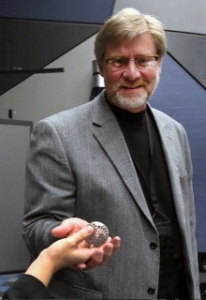Oct 8 2013
Lockheed Martin Space Systems Company hosted community leaders from Leadership Jefferson County to celebrate Manufacturing Day and educate the community on the company’s manufacturing prowess. Local leaders toured the leading-edge Lockheed Martin facility and heard from Dennis Little, vice president of Production, on revolutionizing manufacturing.
 Dennis Little, vice president of Production, demonstrates 3D printing technology during Manufacturing Day 2013 activities.
Dennis Little, vice president of Production, demonstrates 3D printing technology during Manufacturing Day 2013 activities.
Transforming Production with the Digital Tapestry
During his presentation, Little unveiled the next-generation digital manufacturing technologies that Space Systems Company integrates into the production cycle. These technologies form the company’s “digital tapestry,” a seamless digital environment driven by integrated Model Based Engineering (MBE) tool set that keeps the digital data intact from conceptualization to realization.
“Our Digital Tapestry of production brings digital design to every stage of the production process for a fluid product development cycle,” said Little. “From 3D virtual pathfinding simulations to 3D printing, we are using innovative digital technology to streamline the manufacturing process for lower cycle times and reduced costs for our customers.”
3D Printing Titanium Parts
Space Systems Company is implementing 3D printing technology, also known as additive manufacturing, to print titanium satellite parts – reducing cost, cycle time and material waste. 3D printing is a process of making three-dimensional objects directly from a computer model. This process is achieved using an additive process. A material, such as titanium, is heated and then applied in successive layers to create almost any shape. When a product is printed using additive manufacturing, waste is minimized and cycle time is drastically reduced. Space Systems Company is currently using this process to develop printed satellite parts and plans to continue expanding the process in the future to complex parts and maybe even full satellites.
Virtual Pathfinding with 3D Simulation Technology
By using 3D pathfinding simulation technology called the Collaborative Human Immersive Laboratory (CHIL), Space Systems Company can identify areas to improve affordability and operational excellence throughout the entire lifecycle of our products. The CHIL is an advanced virtual reality and simulation laboratory that offers a smarter, cheaper and lower risk opportunity in building space systems, including satellites, exploration spacecraft, launch vehicles and missile defense systems. The facility enables virtual creation before the physical creation to improve the affordability of our products and associated processes. Space Systems Company is applying this innovative technology across the business’s programs to improve production processes.
“Virtual pathfinding and 3D printing are just two of the innovations we are implementing at Space Systems Company to digitalize the production process,” said Little. “From conceptualization to realization, we continue to look for new opportunities to improve the production cycle with advanced technology. In this industry, we have to continuously lean forward to new technologies to stay affordable, efficient and reliable for our customers.”
Following the presentation, the visitors saw the innovation first hand on a tour of the Space Systems Company facility in Littleton, Colo., including the CHIL, the Final Assembly Building, and the Space Operations Simulation Center.